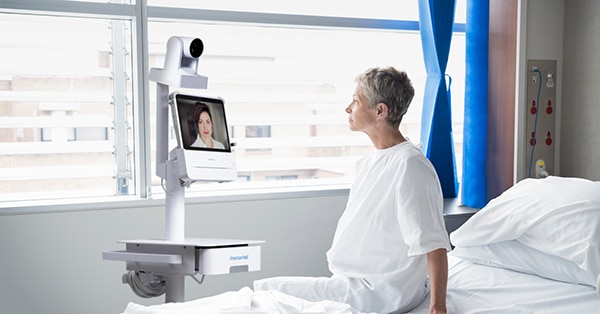How Hospitals & Health Systems Can Leverage Telehealth for COVID-19
With HIMSS 2020 being canceled due to COVID-19 fears, the opportunity to use the event to convene some of the world’s greatest medical professionals and technology innovators to discuss the virus has ceased. While many of these conversations are still taking place from afar, we’re quickly realizing that more needs to be done to fend off the imminent threat of the virus.
This starts with protecting our health care workers who are on the front lines of this disease. To date, much of the conversation has focused on how the American people can and should prepare. However, should COVID-19 spread at the rate and to the degree that many are expecting, we must ensure that our care teams are as ready as possible to help not only fight the outbreak but keep themselves safe.
The Centers for Disease Control and Prevention (CDC) is already beginning to arm healthcare providers, schools and employers on proper infection control strategies. The new buzzword is “social distancing,” which essentially means staying away from crowds. What better way to do so than to get your healthcare from home?
Telehealth can be an important first line of defense when it comes to protecting possible patients, the public at large and the care teams. As I wrote in a Fierce Healthcare article, here are some of the ways hospitals and health systems can and should use telehealth to aid in the fight against COVID-19.
ED diversion
As the spread of COVID-19 continues, health systems can expect to see a surge of patients into their already resource-constrained hospitals. Further, large numbers of patients with respiratory symptoms showing up in emergency departments will overwhelm our infection control measures.
Using telehealth, virtual care teams can screen patients, assign risk, answer questions and recommend the next steps a patient should take. This capability already has been used during influenza outbreaks and has the potential to greatly minimize the demands and risks at in-person care centers, reducing unnecessary infection risk, costs and burden to patients and care teams alike.
In-home monitoring
Already today, the health departments are responsible for monitoring patients under investigation and those with confirmed disease both in the home and in inpatient environments. These workers must go to great lengths to protect themselves when assessing these patients and still must accept risk of contracting the disease.
Telehealth can be utilized through standard consumer devices in the home or cart-based endpoints in the hospital to allow these providers to assess patients without the risk of contracting the disease.
Maximize resources
Across the U.S., we have concentrations of clinical supply: healthcare excellence, expertise, and readily available resources, while at the same time we have areas that are relative care deserts.
Utilizing telehealth can effectively load-balance clinical availability with demand for those clinical resources regardless of geographic constraints or mobility restrictions and enable quality and convenient care at scale. Providers can be projected to rural regions, long-term care facilities and specialists can be projected into critical access or rural hospitals to extend care
Limit clinical exposure to infected patients
As an increasing number of patients become infected with the disease and are hospitalized, the ability for telehealth to allow providers to “see” patients without being in the same room as they cannot be overlooked. Hospitals can use telemedicine carts, for example, to bring a provider into the hospital room of a patient virtually and allow them to examine a patient while keeping that doctor or nurse a safe distance away from the infection. This is especially important during disease outbreaks when patients are to be isolated or quarantined.
Engage patients
Even the best telehealth programs will fall short in value if patients aren’t using the virtual services. It’s not enough for hospitals to simply offer a telehealth service, especially during times of surge and demand.
Instead, they need to inform patients about when and how to use telehealth should they be concerned about COVID-19 and communicate the value to getting seen by a doctor—even their own doctor, who they already know and trust—from the comfort of their home for the benefit of themselves and others.
Above all, coordination across providers, care teams, hospitals, health systems, and government agencies like the CDC is critical. We must create open lines of communication between all of those on the front lines of the epidemic, enabling stepwise care and referrals that minimize the risk of spread.
We must help each other, inform one another, follow the guidelines created by the experts and pool resources as necessary (using telehealth to assist with managing clinical resources).
We must also continue not to panic but rather get and stay prepared. The latest CDC guidance for hospital preparedness emphasizes the importance of training and equipping staff so that they are capable of dealing with COVID-19 patients.
As hospital and health systems work to ensure these guidelines are enacted and followed, they should also consider ensuring staff are trained and well-equipped to leverage telehealth to fight against the virus and limit the spread of the disease.


